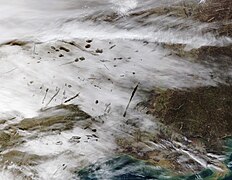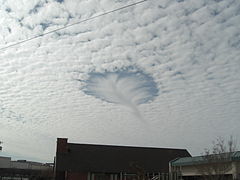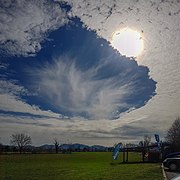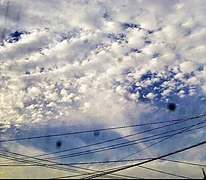Fallstreak hole
| Fallstreak hole (Cavum) | |
|---|---|
 Fallstreak hole over Austria, August 2008. | |
| Abbreviation | cav |
| Variety | Supplementary feature |
| Appearance | Hole in the clouds |
| Precipitation cloud? | Virga |
A fallstreak hole (also known as a cavum,[1] hole punch cloud, punch hole cloud, skypunch, cloud canal or cloud hole) is a large gap, usually circular or elliptical, that can appear in cirrocumulus or altocumulus clouds. Because of their rarity and unusual appearance, fallstreak holes have been mistaken for or attributed to unidentified flying objects.[2]
Origin[]
Such holes are formed when the water temperature in the clouds is below freezing, but the water, in a supercooled state, has not frozen yet due to the lack of ice nucleation. When ice crystals do form, a domino effect is set off due to the Bergeron process, causing the water droplets around the crystals to evaporate: this leaves a large, often circular, hole in the cloud.[3] It is thought that the introduction of large numbers of tiny ice crystals into the cloud layer sets off this domino effect of fusion which creates the hole.
The ice crystals can be formed by passing aircraft, which often have a large reduction in pressure behind the wing- or propeller-tips. This cools the air very quickly, and can produce a ribbon of ice crystals trailing in the aircraft's wake. These ice crystals find themselves surrounded by droplets, and grow quickly by the Bergeron process, causing the droplets to evaporate and creating a hole with brush-like streaks of ice crystals below it. An early satellite documentation of elongated fallstreak holes over the Florida Panhandle that likely were induced by passing aircraft appeared in Corfidi and Brandli (1986).[4] Fallstreak holes are more routinely seen by the higher resolution satellites of today (e.g., see third example image in this article).
The articles by Westbrook and Davies (2010)[5] and Heymsfield et al. (2010)[6] explain the processes behind the formation of fallstreak holes in greater detail, and show some observations of their microphysics and dynamics. Such clouds are not unique to any one geographic area and have been photographed from many places.
Examples[]

Elongated fallstreak hole over Bixby, Feb 21, 2020 at 1627 CST

Fallstreak hole over Ann Arbor, Nov 14, 2016

Satellite image of canals and fallstreak holes over east Texas and Louisiana, Jan 2007

Fallstreak Hole over Naples, Italy, December 26, 2018

Fallstreak Hole over Oklahoma City, Oklahoma, January 2010

Fallstreak, Italy, Borso del Grappa, March 19, 2019

A fall streak hole in Northern Mexico, March 23, 2021
See also[]
- List of cloud types
- Circumhorizontal arc
- Cloud iridescence
- Distrails
- Virga
References[]
- ^ Sutherland, Scott (March 23, 2017). "Cloud Atlas leaps into 21st century with 12 new cloud types". The Weather Network. Pelmorex Media. Retrieved 24 March 2017.
- ^ 'UFO cloud formation' filmed in Romania 26 October 2009 www.telegraph.co.uk, accessed 13 October 2021 (subscription required)
- ^ "Cloud Appreciation Society | Fallstreak Holes (February '06)". cloudappreciationsociety.org. Retrieved 2017-07-29.
- ^ Corfidi, Stephen; Brandli, Hank (May 1986). "GOES views aircraft distrails" (PDF). National Weather Digest. 11: 37–39.
- ^ Westbrook, Chris; Davies, Owain (July 2010). "Observations of a glaciating hole-punch cloud". Weather. 65 (7): 176–180. arXiv:0907.4302. Bibcode:2010Wthr...65..176W. doi:10.1002/wea.504.
- ^ Heymsfield, Andrew J.; Kennedy, Patrick C.; Massie, Steve; Schmitt, Carl; Wang, Zhien; Haimov, Samuel; Rangno, Art (2010). "Aircraft-Induced Hole Punch and Canal Clouds: Inadvertent Cloud Seeding". Bulletin of the American Meteorological Society. 91 (6): 753–766. Bibcode:2010BAMS...91..753H. doi:10.1175/2009BAMs2905.1.
External links[]
| Wikimedia Commons has media related to Cavum (meteorology). |
- Clouds
- Unidentified flying objects
- Atmospheric science stubs






